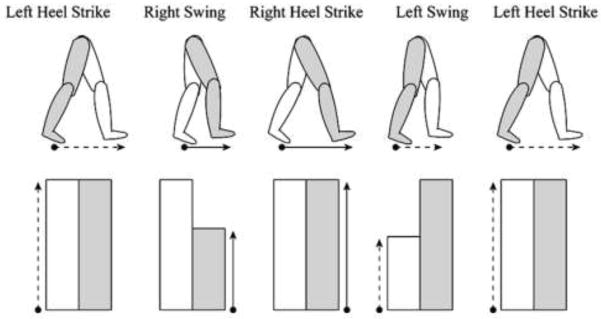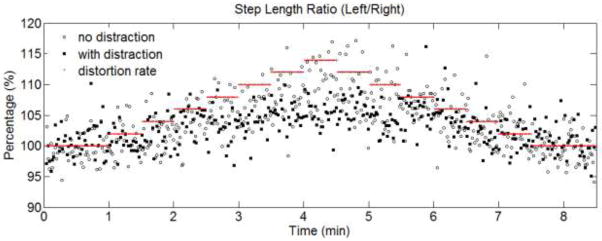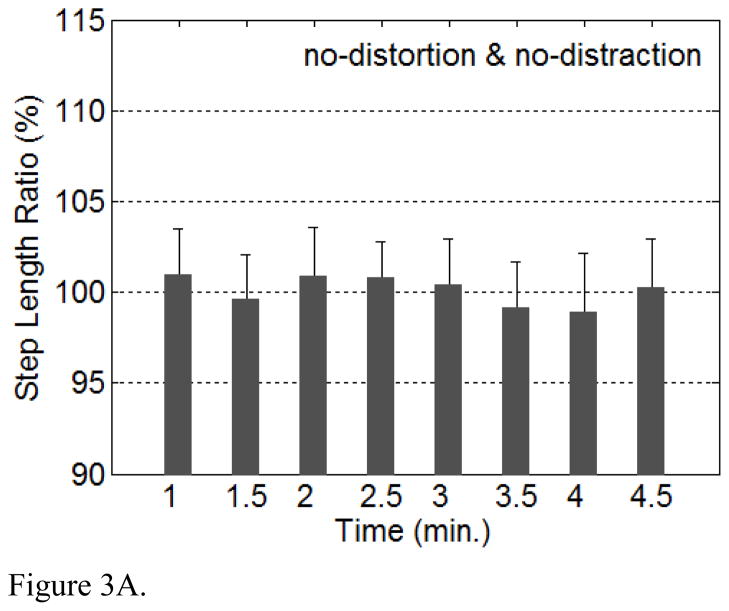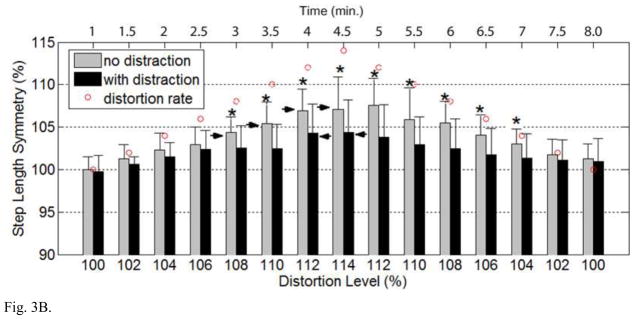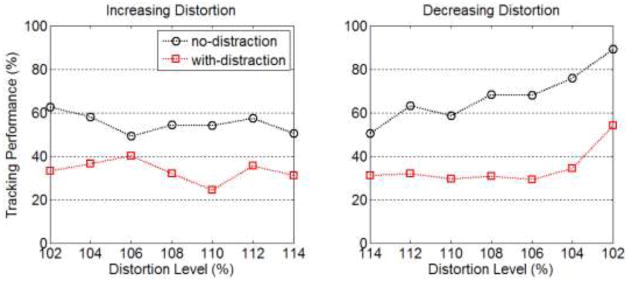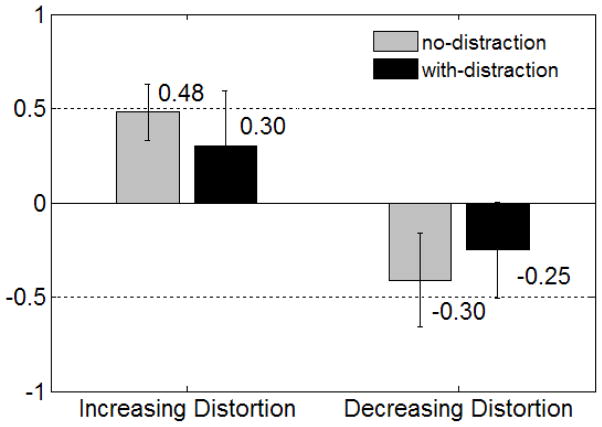Abstract
Gait rehabilitation after stroke often utilizes treadmill training delivered by either therapists or robotic devices. However, clinical results have shown no benefit from this modality when compared to usual care. On the contrary, results were inferior, perhaps because in its present form it is not interactive and at least for stroke, central pattern generators at the spinal level do not appear to be the key to promote recovery. To enable gait therapy to be more effective, therapy must be interactive and visual feedback appears to be an important option to engage patients’ participation. In this study, we tested healthy subjects to see whether an implicit “visual feedback distortion” influences gait spatial pattern. Subjects were not aware of the visual distortion nor did they realize changes in their gait pattern. The visual feedback of step length symmetry was distorted so that subjects perceived their step length as being asymmetric during treadmill training. We found that a gradual distortion of visual feedback, without explicit knowledge of the manipulation, systematically modulated gait step length away from symmetry and that the visual distortion effect was robust even in the presence of cognitive load. This indicates that although the visual feedback display used in this study did not create a conscious and vivid sensation of self-motion (the properties of the optical flow), experimental modifications of visual information of subjects’ movement were found to cause implicit gait modulation. Nevertheless, our results indicate that modulation with visual distortion may require cognitive resources because during the distraction task, the amount of gait modulation was reduced. Our results suggest that a therapeutic program involving visual feedback distortion, in the context of gait rehabilitation, may provide an effective way to help subjects correct gait patterns, thereby improving the outcome of rehabilitation.
Keywords: gait rehabilitation, vision, visual feedback distortion, modulation of locomotion, step length symmetry
Introduction
Gait rehabilitation therapy often employs treadmill training delivered by either therapists or robotic devices, and it has been applied to stroke (Plummer et al. 2007; Goldshmit et al. 2008), spinal cord injury (Dietz and Harkema 2004), or traumatic brain injury (Seif-Naraghi and Herman 1999). The underlying hypothesis is that intensive, repetitive movements mimicking the kinematics of healthy subjects’ gait might strengthen spinal cord central pattern generators and improve the ability to control the limb (Werner et al. 2002; Aagaard 2003; Dietz 2003; Plummer et al. 2007). Although treadmill training with body-weight support has been shown to promote activity-dependent plasticity, thus enhancing motor recovery after a stroke and spinal cord injury (Fouad and Pearson 2004; Plummer et al. 2007), at least for stroke, the effects of treadmill training in rehabilitation delivered by either therapists (LEAPS study) or robotic devices (such as Lokomat) led to inferior results when compared to conventional therapy (Hornby et al. 2008; Hidler et al. 2009). Among potential ways to enhance the effectiveness of treadmill training in stroke recovery and move beyond concepts of central pattern generation, it may be critical to promote interactive participation of the subject in the training stimulating motor learning processes and leading to better functional outcomes (Schmidt and Young 1991; Winstein 1991; Young and Schmidt 1992). Hence, rehabilitation strategies often integrate some form of visual or audio feedback to promote patients’ participation (Krebs et al. 2000; Duschau-Wicke et al. 2010). In particular, visual feedback can be used to engage the patient in an interactive game and to promote motor learning by providing a measure of subjects’ training performance (“knowledge of results” and “knowledge of performance”). For instance, manipulating the visual feedback for hand rehabilitation showed enhanced therapeutic outcomes (Brewer et al. 2008). Additionally, visual feedback might influence correction of patients’ gait movement patterns (Rossignol et al. 2006). This paper describes our efforts to manipulate visual feedback in the context of treadmill training and also to examine its feasibility as a novel rehabilitation strategy for the MIT-Skywalker (Bosecker and Krebs 2009), which is a mechanized gait trainer employing the concept of passive-walkers (Collins et al. 2001) and enabling the expression of natural dynamics of lower limbs. In this study, we have investigated in healthy subjects the role of implicit visual feedback distortion on a task designed to influence modulation of gait symmetry. The right and left step lengths during treadmill training were measured and displayed to subjects. While subjects were unaware, we distorted the visual feedback of the step lengths. Our hypothesis was that implicit visual feedback distortion could affect the stepping pattern of healthy subjects, influencing gait symmetry. Of notice, while much of the literature would suggest that gait is primarily the domain of central pattern generators (CPG) (Dietz 2003), a positive outcome would indicate the importance of supraspinal functions in gait control and suggest a path to introduce such distortions during gait rehabilitation.
Materials and Methods
Subjects
Twelve young healthy volunteers with normal vision (6 males and 6 females; mean age, 27.3±2.8 years) participated in the experiment with visual distortion. All of the subjects were naïve to the experiment, were familiar with walking on a treadmill, and gave informed written consent before participating. The experimental protocols were approved by the Massachusetts Institute of Technology COUHES (Committee on the Use of Humans as Experimental Subjects).
We also employed data collected during the design phase of our experimental protocol with nine subjects to exemplify the variability in step length symmetry during normal treadmill walking (no-distortion/no-distraction).
Experimental setup
Subjects practiced walking on a treadmill for 10 to 15 minutes and determined their comfortable walking speed (range 2.9~3.7 Km/hour). They continued to walk comfortably on the treadmill with a visual display providing feedback of their step lengths. The instruction given to subjects was succinct. They were instructed to walk comfortably while looking at the visual display during the entire walking period. A computer screen (17” LCD monitor with 1280 by 1024 pixel resolution) was placed in front of the treadmill.
The visual feedback included the step length represented by two bar graphs depicting the right and left step size (Fig. 1). The step length was defined as the distance between two feet when a heel-strike occurred for one leg. The visual feedback consisted of the height of the bars representing the instantaneous distance between two feet, so that the bars gradually increased during the swing phase (two feet moving apart). The bar’s maximum height occurred when a heel-strike occurred on the corresponding side, and the maximally displayed bar trace stayed on until the following swing phase began. We explained to the subjects the meaning of the bar graph and they indicated full comprehension during the initial practice without any distortion. During the distortion task, we distorted the length of the bar representing the right side in increments of 2% of the actual step length. For example, 4% of distortion changed the scaling factor between the actual right step length and the displayed bar height from 100% to 104%. In this way, subjects visually perceived that their right step length was 4% longer than the actual length during visual distortions.
Fig. 1.
Visual feedback display. The range of the right and left step length was mapped to the visual feedback bars, shown in the bottom row. During the swing phase of a leg, the corresponding bar increased in real time proportional to the step length and stops when heel strike occurs for that leg. The range of step length mapped to the visual bar was then gradually distorted.
Step length was collected using an electromagnetic tracking system (TrakSTAR system, Ascension Technology Corporation, Burlington, VT). Two wired sensors (19.8 mm long and 7.9 mm wide) were placed bilaterally over the toe regions; the transmitter, which tracked the position of sensors, was located in front of subjects.
Procedure
The distortion experiment was divided into two blocks. Each block lasted 8.5 minutes with the first minute consisting of steady walking at the subject’s preferred speed without any distortion followed by 6.5 minutes of visual distortion-influenced walking. The block ended with 1 minute of walking without distortion. During the entire 8.5-minute trial, subjects kept looking at visual feedback display as instructed. The distortion was gradually increased by increments of 2% up to 114%, and then decreased by 2% down to 100%, which represented initial (no distortion) level. Each distortion level lasted for 30 seconds. After 20 minutes of rest, subjects initiated the second block which included a distraction task in addition to the procedure employed during the first block. The distraction task consisted in asking subjects to subtract 7 out loud starting at 1000 (Yogev et al. 2005).
Data Analysis
The primary measurement used in this study was step length symmetry. The ratio (%) between left and right step length was calculated for each stride to create the step symmetry value. Thus, a step symmetry value greater than 100% meant that the right step was shorter than the left step and vice versa for values smaller than 100%. Post-hoc multiple comparisons followed by one-way ANOVA were employed to examine whether there was a significant variation in gait step symmetry over the entire trial. A Bonferroni correction (0.05/15 = 0.0033) was applied to examine changes in the symmetry metric from baseline to baseline.
The mean step symmetry values over different distortion levels (with 30-second period at each level) were calculated per subject and used to test the changes in step asymmetry induced by visual distortion. These parameters were also used to compare the changes in step asymmetry between the conditions of no cognitive load (no-distraction) and of cognitive load (with-distraction). Since there were two variables (distortion level and distraction condition) observed to affect step length symmetry, we employed two-way repeated measures ANOVA to examine whether there was a significant effect of distortion level and cognitive load (distraction condition) on the changes in step length symmetry.
If we observed significant differences with the ANOVA, we determined at what visual distortion level the step symmetry differs (at a 5% level). This procedure was done separately when increasing the distortion and when decreasing it for both distraction and no-distraction conditions. To investigate the effect of distraction on step length symmetry, we performed a paired t-test comparing the step length symmetry under the no-distraction and distraction conditions at each distortion level. We employed SPSS software for all statistical analysis (SPSS Inc., version 18). The linear relationship between distortion and gait symmetry changes was also analyzed using correlation analysis and indicated by Pearson correlation coefficients. We employed MATLAB function “corrcoef” to perform the correlation analysis (MathWorks Inc., version R2007a).
Results
Fig. 2 shows an example of changes in step length symmetry (expressed as a ratio) as a function of time for a subject obtained for two different conditions (no-distraction and with-distraction conditions). A stride consists of a right and a left step, so the number of points in the plot indicates the total number of strides during the trial. Each point represents the step length symmetry of each stride. The intermittent horizontal lines in the plot indicate the applied distortion increments and decrements at a given period. As shown in Fig. 2, we observed a marked upward or downward trend in step symmetry, tracking the visual feedback distortions. Note that during the distraction task, the amount of change in the step symmetry was reduced.
Fig. 2.
Example of changes in step length ratio as a function of changes in visual distortion. The horizontal axis shows time; the vertical axis shows step length ratio between the left and right actual step lengths. The white circles represent the ratios during the no-distraction condition, and the solid squares represent those during the distraction condition. The intermittent horizontal lines indicate distortion increments applied during those time periods. This plot indicates that the step symmetry was implicitly modulated in response to visual feedback distortion.
Fig. 3A shows an example of the variability in step length symmetry during normal treadmill walking (no-distortion and no-distraction condition) averaged across nine subjects during the design phase of the experiment. Error bars represent ±one standard deviation (SD). The changes of step length symmetry indicate a small degree of fluctuation over time. However, there were no significant variations in step length symmetry over the entire trial (F(7,64)=0.838, p=0.56). On the other hand, Fig. 3B shows the changes in step length symmetry under visual distortion with two different conditions (no-distraction and with-distraction), averaged across twelve subjects, as a function of varying visual feedback distortion. The bars represent the mean step symmetry values induced by visual distortions. On average, the mean step length symmetry steadily increased and then decreased according to the visual feedback distortions, indicating that distortion affected gait symmetry. The statistical analysis showed that there were significant effects of the distraction (cognitive load) and of the distortion level on visually perturbed step length symmetry, F(1,11)=50.508 (p<0.001) and F(14,154)=16.884 (p<0.001), respectively. The interaction test showed that the effects of the distortion levels on step length symmetry were different depending on the distortion conditions, and on the distortion levels (p<0.001). During the period when the distortion was increased, significant changes in step length symmetry were found (p<0.001) at the distortion levels that were equal and greater than 108% compared to the baseline (100% distortion level). Under the distraction condition, significant changes in step length symmetry were found (p<0.001) at the distortion levels that were equal and greater than 112% compared to the baseline. These significant changes were indicated by the solid arrows in Fig. 3B.
Fig. 3.
A) Example of variability in step length symmetry ±one standard deviation during the 4.5-minutes trial, averaged across nine subjects during no-distraction and no-distraction treadmill walking. The horizontal axis shows time and the vertical axis shows changes in mean step length symmetry ratio. B) Changes in step length symmetry (ratio) as a function of varying visual feedback distortion ±one standard deviation, averaged across all experimental subjects during no-distraction and with-distraction conditions and across the control condition. The gray bars show changes for the no-distraction condition, and the black bars show them for the distraction condition. The horizontal axis shows changes in the distortion rate from the onset of the trial, and the vertical axis shows changes in mean step length symmetry ratio. The step length ratio was calculated by . The small circles indicate distortion changes applied during trials. Only during the first half of the trial when the distortion was increased were the solid arrows marked at distortion levels where the step symmetry values were significantly different from the initial 100% period (p=0.001, <0.001, <0.001, and <0.001 for no-distraction task, and p=0.002, and 0.001 for with distraction task). The asterisks (*) were marked at distortion levels where the induced step symmetry values were shown to be significantly different between the no-distraction and with-distraction conditions (p = 0.0141, 0.0007, 0.0002, 0.0017, <0.0001, 0.0019, 0.0009, 0.0053, and 0.0168, respectively).
As shown in the plot, under the distraction condition, the effect of visual distortion on changes in step symmetry was reduced. As indicated by asterisks (*) in Fig. 3B, in the distraction task, paired t-tests for distinct distortion levels showed that the effect of visual distortion on step symmetry modulation was significantly lower than in the no-distraction trial over the entire trial except for the first 6% and last 4% distortion (p = 0.0141, 0.0007, 0.0002, 0.0017, <0.0001, 0.0019, <0.0001, 0.0053, and 0.0168, respectively).
To quantitatively estimate the extent to which visual feedback distortions have induced the step asymmetry, we measured tracking performance indicating the percentages and how much the induced step symmetry tracked the applied visual distortion. This performance was defined by . Thus, a 100% tracking performance implies that an induced step asymmetry has tracked perfectly to a visual distortion, and 0% means that a visual distortion has not affected the gait at all (step symmetry is still 100%, indicating being symmetric). Fig. 4 shows the tracking performance for the no-distraction and the with-distraction conditions, obtained from the group mean step length symmetry values, as a function of visual distortion level. During the first-half period when the distortion was increased, it was observed that the amount of induced step symmetry looked relatively steady regardless of the level of distortion. The mean tracking performance values were 55.1 ± 4.6% and 33.3 ± 5.0% for the no-distraction and the with-distraction conditions, respectively.
Fig. 4.
Tracking performance of the induced step length symmetry for the no-distraction and the with-distraction conditions, obtained from the group means. The performance value was defined by . The left plot shows changes in tracking performance in the first-half trial where the distortion was increased, and the right plot shows them in the last-half trial where distortion was decreased. The horizontal axis shows changes in distortion level. The circles in the plot represent tracking performance in the no-distraction condition, and the squares represent the distraction condition.
In order to estimate the strength of the relationship between visual distortion and induced step asymmetry, we also examined their correlation. On average for twelve subjects, correlation analyses revealed a moderate trend toward modulating step symmetry in response to visual feedback (Fig. 5). With the distraction task, the correlation became less significant. For each set of individual subject data from only the no-distraction trial, the step symmetry values during the increasing distortion period were subtracted from those during the decreasing distortion period at the same distortion levels. The subtracted values are displayed in a histogram plot whose bin width is 0.4%.
Fig. 5.
Mean correlation coefficient calculated between the changes in step length symmetry and the changes in visual distortion level, from the no-distraction and the with-distraction conditions, when the distortion was increased (left) and decreased (right).
Discussion
Effects of distorting visual feedback on step length symmetry
Human locomotion appears to be more than central pattern generators. It appears to require the integration of different sensory information including visual, vestibular, and somatosensory systems (Armstrong 1986; Rossignol 1996). In particular, gait patterns are not only explicitly but also implicitly influenced by visual feedback. It has been shown that changing the speed of virtual environments using virtual reality technology influences balance or modulates walking speed (Prokop et al. 1997; Varraine et al. 2002; Lamontagne et al. 2007; Sheik-Nainar and Kaber 2007). These results suggest a link between the visual perception of movement and locomotion. While numerous studies have examined the role of visual information on the control of different gait parameters, very little attention has been devoted to utilizing them to modulate gait during rehabilitation. Here, we have investigated the role of visual information in driving change in gait pattern using a paradigm of implicit visual feedback distortion. We provided healthy subjects with visual feedback of their step length during treadmill walking (Fig. 1) and implicitly (i.e., without subject knowledge) distorted the visual feedback in a way that subjects perceived their step symmetric pattern as being asymmetric.
At this point, we demonstrated that the implicit visual feedback distortion influenced all subjects and induced them to modulate their gait step symmetry (Fig. 2 and Fig. 3B). Moreover, the observed step symmetry systematically increased or decreased according to the distortion levels. This suggests that subjects spontaneously modulated their spatial gait pattern to compensate for the asymmetric representations of visual feedback. In addition, we observed some differences in the slope of induced step symmetry versus visual distortion level between the increasing and the decreasing distortion periods. We observed during the correlation analysis (Fig. 5) that the slope of downward trend in step symmetry was slightly lower than the upward trend in both the no-distraction and the with-distraction trials. We are presently investigating this apparent “hysteresis” and speculate that perhaps these results may indicate a different timeline or phases for the implicit adaptation.
Interestingly, during post-experiment debriefing, all of the subjects neither noticed the visual distortions nor noticed changes in their gait symmetry. They reported that they were maintaining their natural gait pattern, remaining unaware of changes away from a symmetric gait pattern. Therefore we speculate on whether or not the role of supraspinal function through visual system is the most dominant form of feedback. If true, then the proprioceptive signals coming from the lower limbs and potentially driving central pattern generators is subordinate to the supraspinal ones in gait control (Pailhous et al. 1990; Varraine et al. 2002). This result might provide an important step towards future gait therapy strategies: while we cannot rule out the importance of the central pattern generators residing at the spinal cord level for gait in humans(Bussel et al. 1996), our results suggest the significant role of supraspinal function in gait control through visual system.
Effects of cognitive loading on modulation of gait symmetry
To confirm whether the effects of distorting visual feedback on gait modulation would entail implicit processes, we included a cognitive distraction task that would reduce cognitive resources and impact executive function. We saw an overall reduction in the effect of visual feedback distortion (Fig. 3B, Fig. 4, and Fig. 5). As shown in Fig. 3B, the relationship between the changes in visual distortion and the changes in step symmetry in the distraction trial was smaller than in the no-distraction trial. In other words, the distraction task required a larger change in distortion level in order to induce significant changes in the step symmetry. Although higher-level cognitive resources are not necessarily confined to conscious or voluntary action, these results indicate that higher-level cognitive resources might be associated with the observed gait modulation produced by the visual distortion, which may corroborate the role of supraspinal involvement in walking (Rossignol 1996; Hausdorff et al. 2005). However, the implicit nature and effect of visual distortion on gait is a robust phenomenon, with subjects altering their gait pattern away from symmetry when the visual feedback was distorted even in the presence of an explicit distraction task.
Walking with a symmetric pattern should be “automatic” in our experiment because subjects were not deprived of their proprioception information, which was unchanged here. However, the subjects were not able to perform symmetric gait when the visual feedback was distorted. It was as though the visual feedback distortion modulated the spatial parameters of locomotion despite the fact that subjects thought that they walked normally. Thus, this observation suggests that implicit visual feedback distortion used in this study may have an important role when compared to proprioceptive inputs during walking. In our study, the visual feedback distortion alters the predicted visual consequences of the motor commands such that the step length symmetry displayed in a computer screen is not where it is expected to be. We speculate on whether such prediction error in visual sensory may drive the spontaneous modulation of step length symmetry (Tseng et al. 2007; Shadmehr et al. 2010). It has been shown that the motor system generally responds to sensory prediction errors by stressing a more implicit strategy (Bronstein et al. 2009).
Utilizing visual feedback distortion as a rehabilitation intervention
Our results suggest the potential of employing visual information during gait therapy. The visual information we provided consisted of simple bar graphs representing step length, and these did not evoke any illusion in the visual field on the retina. However, subjects spontaneously responded and also modulated their gait pattern in response to this implicit visual feedback distortion. These results might herald a promising approach for gait rehabilitation because the paradigm of implicit visual feedback distortion can be used as a therapeutic intervention to drive correction of affected gait patterns or to encourage subjects’ movements. Our result complements Malone and Bastian (2010), who in a split-treadmill perturbation walking study found that healthy subjects trained with a dual paradigm that included a distraction task retained after-effects longer than subjects who received explicit correction instructions, suggesting that implicit processes engaged in the distraction group may lead to improved retention (Malone and Bastian 2010). This is particularly important in rehabilitation as ultimately we are interested in optimizing recovery and retention of improvement gains. Therefore, the potential of using such implicit visual distortion for gait rehabilitation might lead to a better motor retention process.
Conclusion
The present study investigated the effect of an implicit visual feedback distortion paradigm on influencing modulation of step length symmetry (a spatial gait pattern). Our results showed that subjects spontaneously modulated their gait symmetric pattern away from actual symmetry according to the implicit distortion of visual feedback. The effect of visual feedback distortion on changes in step symmetry appears to involve both cognitive and implicit resources and might be employed as an approach to shape and challenge patients during rehabilitation robotics.
Acknowledgments
This work was supported in part by the Veterans Administration Baltimore Medical Center “Center of Excellence on Task-Oriented Exercise and Robotics in Neurological Diseases” B3688R. Dr. Krebs is a co-inventor in MIT-held patents for the robotic devices used to treat patients with neurological deficits. He holds equity positions in Interactive Motion Technologies, Inc., the company that manufactures this type of technology under license to MIT.
References
- Aagaard P. Training-induced changes in neural function. Exerc Sport Sci Rev. 2003;31:61–67. doi: 10.1097/00003677-200304000-00002. [DOI] [PubMed] [Google Scholar]
- Armstrong DM. Supraspinal contributions to the initiation and control of locomotion in the cat. Prog Neurobiol. 1986;26:273–361. doi: 10.1016/0301-0082(86)90021-3. [DOI] [PubMed] [Google Scholar]
- Bosecker C, Krebs HI. MIT-Skywalker. International Conference on Rehabilitation Robotics; IEEE, Kyoto, Japan. 2009. pp. 542–549. [Google Scholar]
- Brewer BR, Klatzky R, Matsuoka Y. Visual feedback distortion in a robotic environment for hand rehabilitation. Brain Res Bull. 2008;75:804–813. doi: 10.1016/j.brainresbull.2008.01.006. [DOI] [PubMed] [Google Scholar]
- Bronstein AM, Bunday KL, Reynolds R. What the “broken escalator” phenomenon teaches us about balance. Ann N Y Acad Sci. 2009;1164:82–88. doi: 10.1111/j.1749-6632.2009.03870.x. [DOI] [PubMed] [Google Scholar]
- Bussel B, Roby-Brami A, Neris OR, Yakovleff A. Evidence for a spinal stepping generator in man. Electrophysiological study. Acta neurobiologiae experimentalis. 1996;56:465–468. doi: 10.55782/ane-1996-1149. [DOI] [PubMed] [Google Scholar]
- Collins SH, Wisse M, Ruina A. A three-dimensional passive-dynamic walking robot with two legs and knees. The International Journal of Robotics Research. 2001;20:607–615. [Google Scholar]
- Dietz V. Spinal cord pattern generators for locomotion. Clinical neurophysiology : official journal of the International Federation of Clinical Neurophysiology. 2003;114:1379–1389. doi: 10.1016/s1388-2457(03)00120-2. [DOI] [PubMed] [Google Scholar]
- Dietz V, Harkema SJ. Locomotor activity in spinal cord-injured persons. J Appl Physiol. 2004;96:1954–1960. doi: 10.1152/japplphysiol.00942.2003. [DOI] [PubMed] [Google Scholar]
- Duschau-Wicke A, von Zitzewitz J, Caprez A, Lunenburger L, Riener R. Path control: a method for patient-cooperative robot-aided gait rehabilitation. IEEE Trans Neural Syst Rehabil Eng. 2010;18:38–48. doi: 10.1109/TNSRE.2009.2033061. [DOI] [PubMed] [Google Scholar]
- Fouad K, Pearson K. Restoring walking after spinal cord injury. Prog Neurobiol. 2004;73:107–126. doi: 10.1016/j.pneurobio.2004.04.003. [DOI] [PubMed] [Google Scholar]
- Goldshmit Y, Lythgo N, Galea MP, Turnley AM. Treadmill training after spinal cord hemisection in mice promotes axonal sprouting and synapse formation and improves motor recovery. J Neurotrauma. 2008;25:449–465. doi: 10.1089/neu.2007.0392. [DOI] [PubMed] [Google Scholar]
- Hausdorff JM, Yogev G, Springer S, Simon ES, Giladi N. Walking is more like catching than tapping: gait in the elderly as a complex cognitive task. Exp Brain Res. 2005;164:541–548. doi: 10.1007/s00221-005-2280-3. [DOI] [PubMed] [Google Scholar]
- Hidler J, Nichols D, Pelliccio M, Brady K, Campbell DD, Kahn JH, Hornby TG. Multicenter randomized clinical trial evaluating the effectiveness of the Lokomat in subacute stroke. Neurorehabil Neural Repair. 2009;23:5–13. doi: 10.1177/1545968308326632. [DOI] [PubMed] [Google Scholar]
- Hornby TG, Campbell DD, Kahn JH, Demott T, Moore JL, Roth HR. Enhanced gait-related improvements after therapist- versus robotic-assisted locomotor training in subjects with chronic stroke: a randomized controlled study. Stroke. 2008;39:1786–1792. doi: 10.1161/STROKEAHA.107.504779. [DOI] [PubMed] [Google Scholar]
- Krebs HI, Volpe BT, Aisen ML, Hogan N. Increasing productivity and quality of care: robot-aided neuro-rehabilitation. J Rehabil Res Dev. 2000;37:639–652. [PubMed] [Google Scholar]
- Lamontagne A, Fung J, McFadyen BJ, Faubert J. Modulation of walking speed by changing optic flow in persons with stroke. J Neuroeng Rehabil. 2007;4:22. doi: 10.1186/1743-0003-4-22. [DOI] [PMC free article] [PubMed] [Google Scholar]
- Malone LA, Bastian AJ. Thinking about walking: effects of conscious correction versus distraction on locomotor adaptation. J Neurophysiol. 2010;103:1954–1962. doi: 10.1152/jn.00832.2009. [DOI] [PMC free article] [PubMed] [Google Scholar]
- Pailhous J, Ferrandez AM, Fluckiger M, Baumberger B. Unintentional modulations of human gait by optical flow. Behav Brain Res. 1990;38:275–281. doi: 10.1016/0166-4328(90)90181-d. [DOI] [PubMed] [Google Scholar]
- Plummer P, Behrman AL, Duncan PW, et al. Effects of stroke severity and training duration on locomotor recovery after stroke: a pilot study. Neurorehabil Neural Repair. 2007;21:137–151. doi: 10.1177/1545968306295559. [DOI] [PubMed] [Google Scholar]
- Prokop T, Schubert M, Berger W. Visual influence on human locomotion. Modulation to changes in optic flow. Exp Brain Res. 1997;114:63–70. doi: 10.1007/pl00005624. [DOI] [PubMed] [Google Scholar]
- Rossignol S. Visuomotor regulation of locomotion. Can J Physiol Pharmacol. 1996;74:418–425. [PubMed] [Google Scholar]
- Rossignol S, Dubuc R, Gossard JP. Dynamic sensorimotor interactions in locomotion. Physiol Rev. 2006;86:89–154. doi: 10.1152/physrev.00028.2005. [DOI] [PubMed] [Google Scholar]
- Schmidt RA, Young DE. Methodology for motor learning: a paradigm for kinematic feedback. J Mot Behav. 1991;23:13–24. doi: 10.1080/00222895.1991.9941590. [DOI] [PubMed] [Google Scholar]
- Seif-Naraghi AH, Herman RM. A novel method for locomotion training. J Head Trauma Rehabil. 1999;14:146–162. doi: 10.1097/00001199-199904000-00005. [DOI] [PubMed] [Google Scholar]
- Shadmehr R, Smith MA, Krakauer JW. Error correction, sensory prediction, and adaptation in motor control. Annu Rev Neurosci. 2010;33:89–108. doi: 10.1146/annurev-neuro-060909-153135. [DOI] [PubMed] [Google Scholar]
- Sheik-Nainar MA, Kaber DB. The utility of a virtual reality locomotion interface for studying gait behavior. Hum Factors. 2007;49:696–709. doi: 10.1518/001872007X215773. [DOI] [PubMed] [Google Scholar]
- Tseng YW, Diedrichsen J, Krakauer JW, Shadmehr R, Bastian AJ. Sensory prediction errors drive cerebellum-dependent adaptation of reaching. J Neurophysiol. 2007;98:54–62. doi: 10.1152/jn.00266.2007. [DOI] [PubMed] [Google Scholar]
- Varraine E, Bonnard M, Pailhous J. Interaction between different sensory cues in the control of human gait. Exp Brain Res. 2002;142:374–384. doi: 10.1007/s00221-001-0934-3. [DOI] [PubMed] [Google Scholar]
- Werner C, Bardeleben A, Mauritz KH, Kirker S, Hesse S. Treadmill training with partial body weight support and physiotherapy in stroke patients: a preliminary comparison. Eur J Neurol. 2002;9:639–644. doi: 10.1046/j.1468-1331.2002.00492.x. [DOI] [PubMed] [Google Scholar]
- Winstein CJ. Knowledge of results and motor learning--implications for physical therapy. Phys Ther. 1991;71:140–149. doi: 10.1093/ptj/71.2.140. [DOI] [PubMed] [Google Scholar]
- Yogev G, Giladi N, Peretz C, Springer S, Simon ES, Hausdorff JM. Dual tasking, gait rhythmicity, and Parkinson's disease: which aspects of gait are attention demanding? Eur J Neurosci. 2005;22:1248–1256. doi: 10.1111/j.1460-9568.2005.04298.x. [DOI] [PubMed] [Google Scholar]
- Young DE, Schmidt RA. Augmented Kinematic Feedback for Motor Learning. J Mot Behav. 1992;24:261–273. doi: 10.1080/00222895.1992.9941621. [DOI] [PubMed] [Google Scholar]



